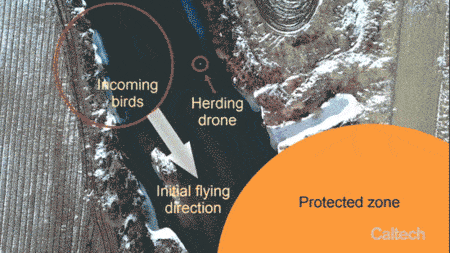
The development of the algorithm – described in a study in IEEE Transactions on Robotics - was inspired by the so-called 2009 "Miracle on the Hudson" incident, when US Airways Flight 1549 struck a flock of geese shortly after take-off and was forced to land in the Hudson River off Manhattan.
"The passengers on Flight 1549 were only saved because the pilots were so skilled," said Soon-Jo Chung, principal investigator on the drone herding project. "It made me think that next time might not have such a happy ending. So I started looking into ways to protect airspace from birds by leveraging my research areas in autonomy and robotics."
Airports are currently protected from birds either by trained falcons or piloted drones. However, these strategies can be costly or—in the case of the hand-piloted drone—unreliable, said Chung.
"When herding birds away from an airspace, you have to be very careful in how you position your drone,” he explained. “If it's too far away, it won't move the flock. And if it gets too close, you risk scattering the flock and making it completely uncontrollable. That's difficult to do with a piloted drone."
Herding relies on the ability to manage a flock as a single, contained entity—keeping it together while shifting its direction of travel. Each bird in a flock reacts to changes in the behaviour of the birds nearest to it. Effective herding requires an external threat—in this case, the drone—to position itself in such a way that it encourages birds along the edge of a flock to make course changes that then affect the birds nearest to them, who affect birds farther into the flock, and so on, until the entire flock changes course.
The positioning has to be precise, however: if the external threat gets too zealous and rushes at the flock, the birds will panic and act individually, not collectively.
To teach the drone to herd autonomously, Chung and his colleagues, including Aditya Paranjape of Imperial College London, studied and derived a mathematical model of flocking dynamics to describe how flocks build and maintain formations, how they respond to threats along the edge of the flock, and how they then communicate that threat through the flock. Their work improves on algorithms designed for herding sheep, which only needed to work in two dimensions, instead of three.
"We carefully studied flock dynamics and interaction between flocks and pursuers to develop a mathematically sound herding algorithm that ensures safe relocation of flocks using autonomous drones," said Kyunam Kim, a co-author of the IEEE paper.
Once they were able to generate a mathematical description of flocking behaviours, the researchers reverse engineered it to see exactly how approaching external threats would be responded to by flocks, and then used that information to create a new herding algorithm that produces ideal flight paths for incoming drones to move the flock away from a protected airspace without dispersing it.
The team tested the algorithm on a flock of birds near a field in Korea and found that a single drone could keep a flock of dozens of birds out of a designated airspace. The effectiveness of the algorithm is only limited by the number and size of the incoming birds, said Chung, adding that the team plans to explore ways to scale the project up for multiple drones dealing with multiple flocks.





Red Bull makes hydrogen fuel cell play with AVL
Surely EVs are the best solution for motor sports and for weight / performance dispense with the battery altogether by introducing paired conductors...